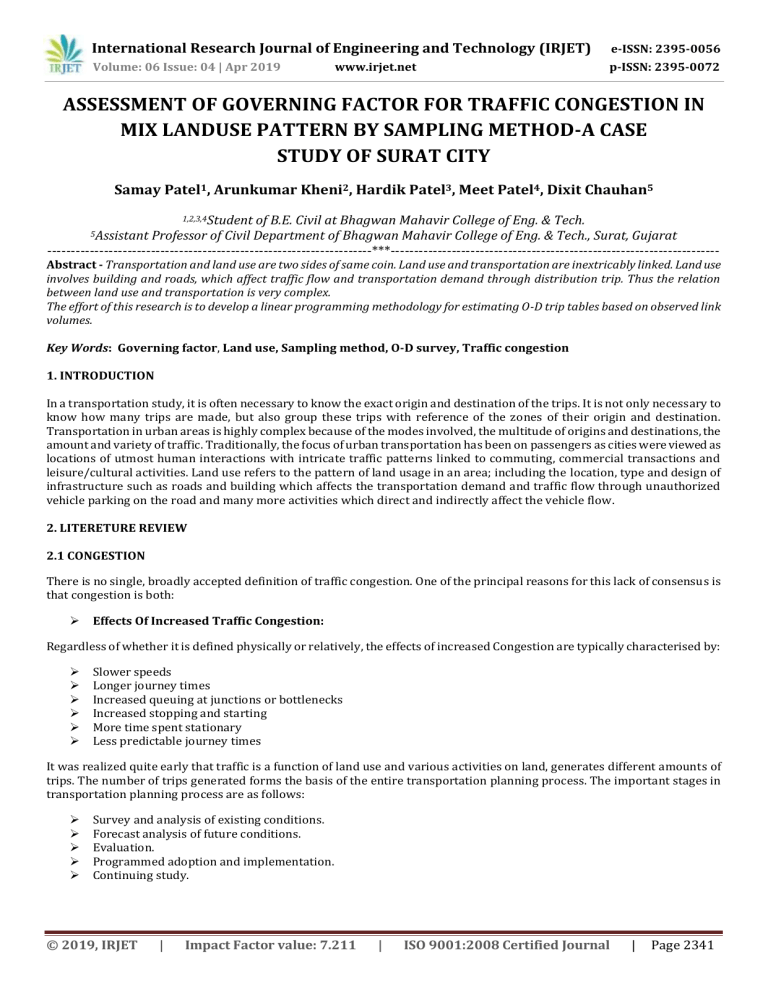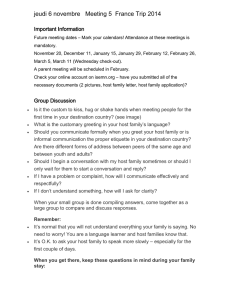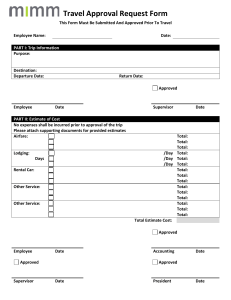IRJET-Assessment of Governing Factor for Traffic Congestion in Mix Landuse Pattern by Sampling Method-A Case Study of Surat City
advertisement

International Research Journal of Engineering and Technology (IRJET) e-ISSN: 2395-0056 Volume: 06 Issue: 04 | Apr 2019 p-ISSN: 2395-0072 www.irjet.net ASSESSMENT OF GOVERNING FACTOR FOR TRAFFIC CONGESTION IN MIX LANDUSE PATTERN BY SAMPLING METHOD-A CASE STUDY OF SURAT CITY Samay Patel1, Arunkumar Kheni2, Hardik Patel3, Meet Patel4, Dixit Chauhan5 1,2,3,4Student of B.E. Civil at Bhagwan Mahavir College of Eng. & Tech. Professor of Civil Department of Bhagwan Mahavir College of Eng. & Tech., Surat, Gujarat ---------------------------------------------------------------------***---------------------------------------------------------------------5Assistant Abstract - Transportation and land use are two sides of same coin. Land use and transportation are inextricably linked. Land use involves building and roads, which affect traffic flow and transportation demand through distribution trip. Thus the relation between land use and transportation is very complex. The effort of this research is to develop a linear programming methodology for estimating O-D trip tables based on observed link volumes. Key Words: Governing factor, Land use, Sampling method, O-D survey, Traffic congestion 1. INTRODUCTION In a transportation study, it is often necessary to know the exact origin and destination of the trips. It is not only necessary to know how many trips are made, but also group these trips with reference of the zones of their origin and destination. Transportation in urban areas is highly complex because of the modes involved, the multitude of origins and destinations, the amount and variety of traffic. Traditionally, the focus of urban transportation has been on passengers as cities were viewed as locations of utmost human interactions with intricate traffic patterns linked to commuting, commercial transactions and leisure/cultural activities. Land use refers to the pattern of land usage in an area; including the location, type and design of infrastructure such as roads and building which affects the transportation demand and traffic flow through unauthorized vehicle parking on the road and many more activities which direct and indirectly affect the vehicle flow. 2. LITERETURE REVIEW 2.1 CONGESTION There is no single, broadly accepted definition of traffic congestion. One of the principal reasons for this lack of consensus is that congestion is both: Effects Of Increased Traffic Congestion: Regardless of whether it is defined physically or relatively, the effects of increased Congestion are typically characterised by: Slower speeds Longer journey times Increased queuing at junctions or bottlenecks Increased stopping and starting More time spent stationary Less predictable journey times It was realized quite early that traffic is a function of land use and various activities on land, generates different amounts of trips. The number of trips generated forms the basis of the entire transportation planning process. The important stages in transportation planning process are as follows: Survey and analysis of existing conditions. Forecast analysis of future conditions. Evaluation. Programmed adoption and implementation. Continuing study. © 2019, IRJET | Impact Factor value: 7.211 | ISO 9001:2008 Certified Journal | Page 2341 International Research Journal of Engineering and Technology (IRJET) e-ISSN: 2395-0056 Volume: 06 Issue: 04 | Apr 2019 p-ISSN: 2395-0072 www.irjet.net Surveys are prerequisite to the planning process. They are Carried- to collect data on various factors that influence the travel behavior. These include inventory of existing travel pattern, that If existing transportation facilities and land use-economic activities. 3. ORIGIN AND DESTINATION SURVEY: The origin and destination study is carried out mainly to know the origin and destination of various vehicles. In this study, the data collected are, number of vehicles, their origin and destination, number of passengers in each vehicle, route etc. 3.1 SURVEY ROUTE We have select three road network for the project work as these route having traffic congestion problem during peak hours. Fig-1: Survey route The route selected are listed below: 1) Anand Mahal road 2) City Light road 3.2 DATA OF SURVEY ROUTE Table-1: Details Of Survey Route Serial No. Route Road Width Distance (km) Number of survey form 1. Anand mahal Road 24 m 2.0 km 150 2. Citylight Road 24 m 2.1 km 150 3.3 DATA ANALYSIS 1. Anand Mahal Road 1. Gender Chart- 1: Gender for Ananad mahal road © 2019, IRJET | Impact Factor value: 7.211 | ISO 9001:2008 Certified Journal | Page 2342 International Research Journal of Engineering and Technology (IRJET) e-ISSN: 2395-0056 Volume: 06 Issue: 04 | Apr 2019 p-ISSN: 2395-0072 www.irjet.net This pie chart shows that the 72% male and 28% uses this route for travel. 2. Age: Chart- 2:Age for Anand mahal road The origin and destination survey conducted the 26-36 age people use this road very much. They use 37% of the total age of the people. 3. Purpose of the trip Chart- 3:Purpose of the trip for anand mahal road This pie chart shows that the most user of the road have their home, personal businesses from our survey. 4. Destination of the trip: Chart- 4.:Destination of the trip for anand mahal road This pie chart shows that the most user of the road are going to Prime arcade Shreeji arcade respectively. © 2019, IRJET | Impact Factor value: 7.211 | ISO 9001:2008 Certified Journal | Page 2343 International Research Journal of Engineering and Technology (IRJET) e-ISSN: 2395-0056 Volume: 06 Issue: 04 | Apr 2019 p-ISSN: 2395-0072 www.irjet.net 5. Mode of the trip: Chart-5:Mode of the trip for anand mahal road The pie chart shows that the people are using two-wheeler more than any any other mode from our survey. 6. No. of days of trip Chart-6:No. of days of trip for Anand mahal road The pie chart shows that the people are using this road for 5-6 days per week From our survey. 7. Requirement of alternative Road: Chart- 7:Requirement for alternative road for Anand mahal Road This pie chart shows that the people don’t want alternative road at anand mahal road from our survey. © 2019, IRJET | Impact Factor value: 7.211 | ISO 9001:2008 Certified Journal | Page 2344 International Research Journal of Engineering and Technology (IRJET) e-ISSN: 2395-0056 Volume: 06 Issue: 04 | Apr 2019 p-ISSN: 2395-0072 www.irjet.net 2. Citylight road 1. Gender Chart- 8:Gender for Citylight road This pie chart shows that the 70% male and 30% uses this route for travel. 2. Age Chart- 9:Age for Citylight road The origin and destination survey conducted the 26-36 age people use this road very much. They use 40% of the total age of the people. 3. Purpose of the trip Chart-10:Purpose of the trip for citylight road This pie chart shows that the most user of the road have their home, personal businesses from our survey. © 2019, IRJET | Impact Factor value: 7.211 | ISO 9001:2008 Certified Journal | Page 2345 International Research Journal of Engineering and Technology (IRJET) e-ISSN: 2395-0056 Volume: 06 Issue: 04 | Apr 2019 p-ISSN: 2395-0072 www.irjet.net 4. Destination of the trip: Chart-11:Destination of the trip for citylight road This pie chart shows that the most user of the road are going to shopping from our survey. 5. Mode of the trip: Chart-12:Mode of the trip for Citylight road The pie chart shows that the people are using two-wheeler more than any any other mode From our survey. 6. No. of days of trip Chart-13: No. of days of trip for Citylight road The pie chart shows that the people are using this road for 6-7 days. It means this road is very busy road. © 2019, IRJET | Impact Factor value: 7.211 | ISO 9001:2008 Certified Journal | Page 2346 International Research Journal of Engineering and Technology (IRJET) e-ISSN: 2395-0056 Volume: 06 Issue: 04 | Apr 2019 p-ISSN: 2395-0072 www.irjet.net 7. Requirement of alternative Road: Chart-14:Requirement for alternative road for Citylight road This pie chart shows that the people don’t want alternative road at citylight road From our survey. 4. CONCLUSION After doing assessment on both road, it shows that both road has governing factor of work by young age group coming by two wheeler. In addition both road highly require alternative route instead of this route. REFERENCES 1. Reid Ewing, Michael Greenwald, Ming Zhang,Jerry Walters,Mark Feldman,Robert Cervero, Lawrence Frank,and John Thomas , “Traffic Generated by Mixed-Use Developments—Six-Region Study Using Consistent Built Environmental Measures”, Journal of Urban Planning Development, September 2011 2. Yan Ou, Shuming Tang and Fei-Yue Wang, “Computational Experiments for Studying Impacts of Land Use on Traffic Systems”, 13th International IEEE Annual Conference on Intelligent Transportation Systems Madeira Island, Portugal, September 19-22, 2010 3. Susan Schock , “Projecting Land-Use Change A Summary of Models for Assessing the Effects of Community Growth and Change on Land-Use Patterns” 4. Steven E. Polzin, "Transportation/Land-use relationship:Public Transit's impact on land-use", Journal of Urban Planning Development, December 1999 5. Partha Pratim Sarkar a1,C. Maullikarjuna b," Effect of Land Use on Travel Behaviour: A Case Study Of Agartala City" 6. Zheng Yu Wang, Wei Li Zhang, Lei Wang, Jin Xin Cao, “Study of influence of parking in the ways on road capacity around schools based on flocking theory”, 13th COTA International Conference of Transportation Professionals (CICTP 2013). 7. Bashirul Haque, Mufuzar Rehman, Abu shayad khan, Muhammad Nahid Parvez, “Impact of Land Use Parameters on Household Travel Behavior ", American Journal of Civil Engineering and Architecture, 2013 8. Leke Oduwaye , “Urban Planning Implications of Changing Land Use Structure of Metropolitan Lagos, Nigeria” 9. Rajesh J Pandya , Dr. B. K. Katti , "Dynamism of Transportation and Land Use Interaction in Urban Context", International Journal of Advancements in Research & Technology, October 2012 © 2019, IRJET | Impact Factor value: 7.211 | ISO 9001:2008 Certified Journal | Page 2347




